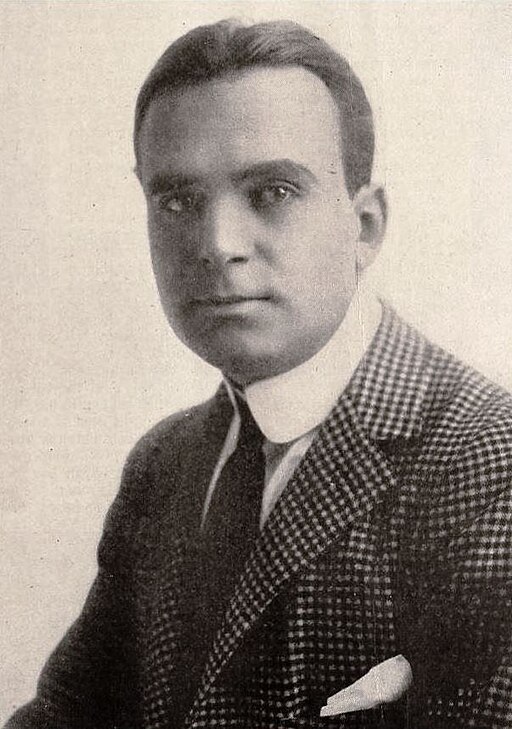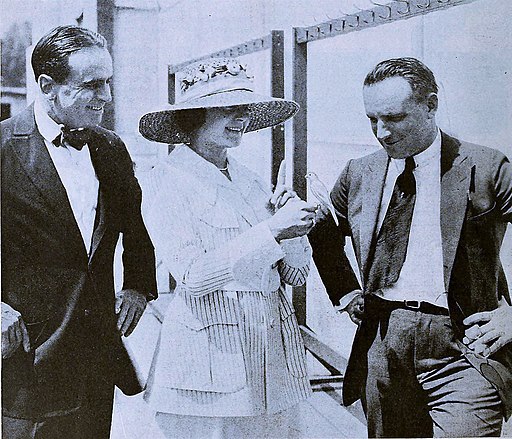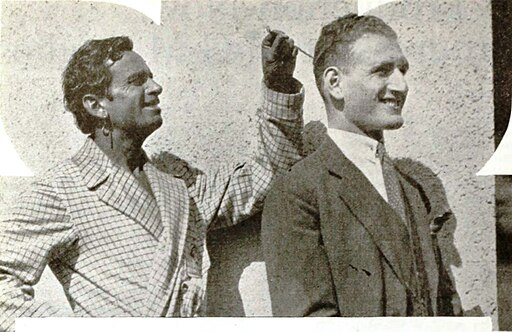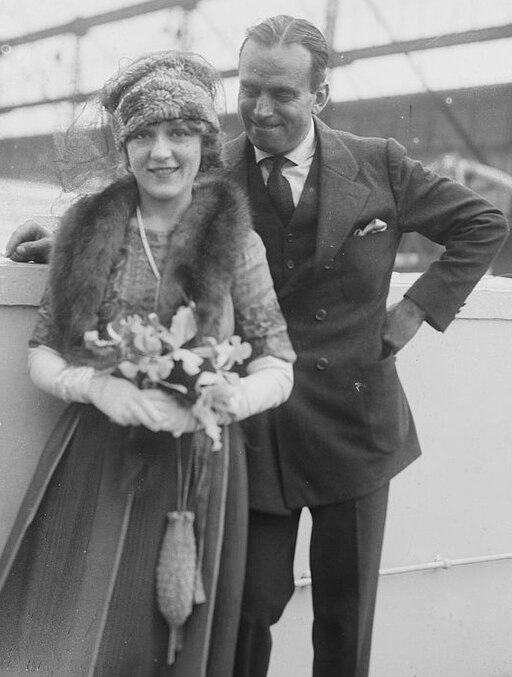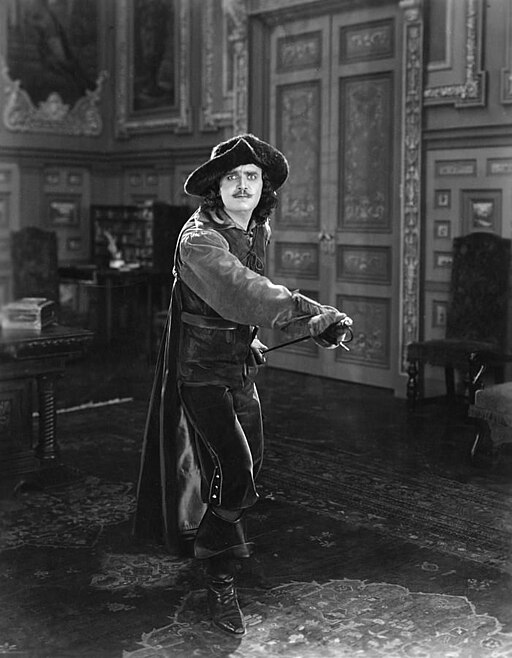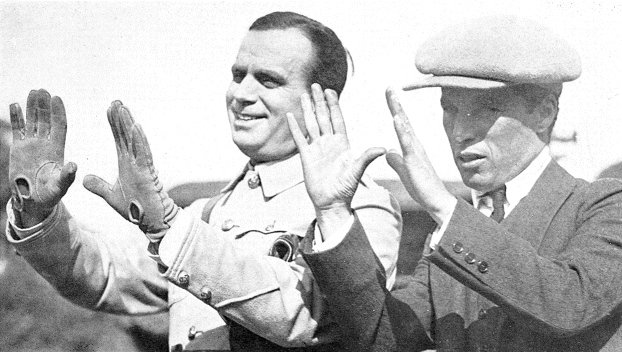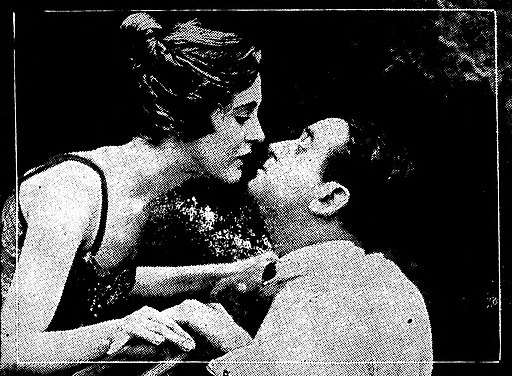Douglas Fairbanks
back| Full Name | Douglas Elton Thomas Ullman |
| Stage Name | Douglas Fairbanks |
| Born | May 23, 1883 |
| Birthplace | Denver, Colorado, USA |
| Died | December 12, 1939 |
| Buried | Hollywood Forever Cemetery, Los Angeles, California, USA |
| Married to | Anna Beth Sully (m. 1907–1919) - Mary Pickford (m. 1920–1936) - Sylvia, Lady Ashley (m. 1936 until his death in 1939) |
| Children | Douglas Fairbanks Jr. (with Anna Beth Sully) |
| Notable films |
Douglas Fairbanks
The King of Hollywood
Douglas Fairbanks, born in 1883, was a seminal figure in early Hollywood, renowned for his charismatic screen presence and athletic prowess. Transitioning from Broadway, he became a silent film superstar, epitomizing the swashbuckling hero in classics like "The Mark of Zorro" (1920) and "The Thief of Bagdad" (1924).
Co-founding United Artists and The Academy of Motion Picture Arts and Sciences, Fairbanks was instrumental in shaping the film industry. Though his career waned with the advent of sound films, his legacy as a pioneer of the action-adventure genre endures.
Douglas Fairbanks (1883 – 1939)
Biography and Career Overview
Early Life
Douglas Fairbanks was born Douglas Elton Thomas Ullman in Denver, Colorado, to Hezekiah Charles Ullman (a lawyer and attorney) and Ella Adelaide Marsh. His charismatic and athletic demeanor was evident from an early age, greatly influencing his future in the performing arts.
Career Beginnings
Fairbanks began his career on the stage in 1900 and made a significant impact in Broadway before moving to film. His early work in silent films was marked by his vigorous, athletic performances, often performing his own stunts, which quickly made him one of the biggest stars of his time.
Rise to Fame
His breakthrough came with "The Mark of Zorro" in 1920, which established his persona as the swashbuckling hero, a theme that would define his most memorable works. Following this success, he starred in a series of adventure films like "The Three Musketeers" and "Robin Hood," which not only captivated audiences but also set the standards for action films.
Personal Life and Marriage
Fairbanks's personal life, especially his marriage to Mary Pickford, another film star, was highly publicized. They were dubbed "Hollywood royalty," hosting many parties at their Beverly Hills home, Pickfair. Their marriage was a significant Hollywood romance until their divorce in 1936.
Later Career and Sound Films
With the advent of sound films, Fairbanks's popularity waned. He found the transition challenging, as it did not suit his action-oriented film persona. He made a few sound films, including "The Taming of the Shrew" (1929), co-starring his then-wife Mary Pickford, but eventually retired from acting.
Legacy
Douglas Fairbanks was a co-founder of United Artists (along with Mary Pickford, Charlie Chaplin, and D.W. Griffith), a company that allowed artists to control their own interests rather than being dependent upon commercial studios. He was also a founding member of the Academy of Motion Picture Arts and Sciences and hosted the first Oscars ceremony in 1929. His legacy in the film industry is profound, influencing the genres of action and adventure cinema. He was posthumously awarded a star on the Hollywood Walk of Fame.
Fairbanks's influence on cinema, particularly in creating and popularizing the swashbuckling genre, has endured. His athleticism, charisma, and pioneering spirit made him a true icon of early American cinema.
Douglas Fairbanks was often dubbed "The King of Hollywood," a title reflective of his status as one of the most influential figures in early American cinema. This nickname not only acknowledged his royal on-screen personas but also his off-screen role as a founding visionary of the film industry.
Video Biography of Douglas Fairbanks:
His early Death:
Douglas Fairbanks passed away on December 12, 1939, at the age of 56. His death was due to a heart attack, a sudden end to the life of one of cinema's most vibrant and energetic figures. At the time of his death, Fairbanks was at his home, Santa Monica, California. His passing marked the end of an era for many, as he was not only a pivotal figure in the silent film era but also a founding force behind many institutions that shaped Hollywood, including United Artists and the Academy of Motion Picture Arts and Sciences.
Fairbanks was survived by his third wife, Lady Sylvia Ashley, and his son, Douglas Fairbanks Jr., who followed in his father's footsteps to become a successful actor in his own right. In accordance with his wishes, Fairbanks was buried at Hollywood Forever Cemetery in Los Angeles, a resting place for many of Hollywood's greatest names. His funeral was attended by many of his contemporaries and friends, including Charlie Chaplin, who was said to be visibly moved by the loss.
Notable Movies Starring Douglas Fairbanks:
1915
- "The Lamb": Fairbanks plays Gerald, a young, wealthy American who proves his worth and bravery during a trip to Mexico, transitioning from a timid man to a hero.
1916
- "His Picture in the Papers": A comedic tale where Fairbanks portrays Pete Prindle, a vegetarian athlete who seeks to prove his worth and win his love interest's heart.
- "The Habit of Happiness": Playing Sunny Wiggins, Fairbanks spreads joy and laughter to cure gloom, showcasing his comedic talents.
1917
- "A Modern Musketeer": Fairbanks' character, inspired by D'Artagnan, seeks adventure and romance in the American West.
- "Down to Earth": As Billy Gaynor, Fairbanks attempts to bring joy and simplicity to a group of pretentious theater folks.
1918
- "Bound in Morocco": Fairbanks stars as George Travelwell, an American in Morocco embroiled in intrigue and adventure, showcasing his trademark athleticism.
- "Mr. Fix It": As Dick Remington, Fairbanks solves others' problems, leading to love and comedy.
1919
- "His Majesty, the American": Fairbanks plays William Brooks, an American adventurer who uncovers and foils a plot against a small European monarchy.
- "When the Clouds Roll by": Fairbanks portrays Daniel Boone Brown, a man subjected to psychological experiments, featuring surreal dream sequences.
1920
- "The Mark of Zorro": As Don Diego Vega, Fairbanks creates the dual identity of Zorro, defending Californians from corrupt officials in this iconic swashbuckler.
1921
- "The Three Musketeers": Portraying D'Artagnan, Fairbanks seeks adventure in Paris and joins the Musketeers in this classic tale of friendship and intrigue.
1922
- "Robin Hood": As the legendary English folk hero, Fairbanks fights injustice and tyranny in one of the first major adaptations of the Robin Hood legend.
1924
- "The Thief of Bagdad": Fairbanks is a thief who seeks to win the heart of a princess in this visually stunning, epic fantasy adventure.
1925
- "Don Q, Son of Zorro": Playing both Don Diego and his son, Don Cesar, Fairbanks embarks on a new adventure to clear his son's name.
1926
- "The Black Pirate": In a groundbreaking color film, Fairbanks avenges his father's death as a daring pirate, showcasing his signature acrobatic stunts.
1929
- "The Iron Mask": Returning as D'Artagnan in this sequel to "The Three Musketeers," Fairbanks finds himself in the midst of royal intrigue and adventure in the late silent film era.
His Marriage with Mary Pickford:
Douglas Fairbanks and Mary Pickford were one of the most celebrated couples of early Hollywood, epitomizing the glamour and allure of the silent film era. They married on March 28, 1920, after both had ended their previous marriages. Their union was not just a romantic partnership but also a powerful alliance between two of the biggest stars of the time, which captivated the public and the press alike.
Their home, Pickfair, a mansion in Beverly Hills, became an iconic symbol of Hollywood's Golden Age, hosting lavish parties attended by celebrities, artists, and intellectuals from around the world. The couple was dubbed "Hollywood royalty," with their relationship being one of the first to be heavily publicized and followed by fans and media.
Professionally, Fairbanks and Pickford were pioneers, co-founding United Artists in 1919 along with Charlie Chaplin and D.W. Griffith. This was a revolutionary move that allowed them greater control over their films and careers. They were also among the founding members of the Academy of Motion Picture Arts and Sciences.
However, their marriage faced challenges, particularly as the transition from silent films to talkies changed the landscape of Hollywood. The couple's careers also took turns, with Pickford's star continuing to rise while Fairbanks faced difficulties adapting to sound films. They divorced in 1936 but remained significant figures in film history, remembered for their contributions to cinema and their storied romance that defined an era.
The Expressive Acting Style of Douglas Fairbanks:
Douglas Fairbanks' acting style was emblematic of the silent film era, characterized by expressive physicality, charismatic presence, and an unrivaled athletic prowess. Without the use of dialogue, Fairbanks communicated emotion, intent, and narrative through exaggerated facial expressions, body language, and movement, which was a hallmark of silent cinema acting techniques. His style was dynamic and energetic, imbued with a sense of joy and vivacity that resonated with audiences worldwide. Here's a more detailed analysis:
Expressive Physicality
In an era where dialogue could not be heard, Fairbanks mastered the art of conveying complex emotions and thoughts through his body movements and facial expressions. His performances were a blend of theatrical gestures and naturalistic expressions, allowing him to communicate effectively with the audience. He was known for his broad smiles, determined gaze, and the ability to shift from comedic light-heartedness to dramatic intensity within the same scene.
Athletic Prowess and Stunt Work
Fairbanks was not just an actor but an extraordinary athlete. His background in gymnastics and his natural athleticism were integral to his acting style. He performed his own stunts, which included leaping across rooftops, sword fighting, and swinging from chandeliers, contributing to the thrilling spectacle of his adventure films. This physical capability not only defined his characters as heroes but also set a new standard for action in cinema.
Charismatic Presence
Fairbanks had a magnetic screen presence that drew viewers into his performances. His energy and enthusiasm were infectious, making his characters likable and relatable. This charisma was a key element of his acting style, allowing him to hold the audience's attention and affection throughout his films. It was this charisma that helped him transition from contemporary comedies to the swashbuckling adventures for which he is best known.
Pioneering the Swashbuckler Genre
Fairbanks' acting style was instrumental in defining the swashbuckler genre. He brought a sense of nobility, honor, and daring to his roles, from Robin Hood to Zorro, which became archetypes for heroic characters in cinema. His ability to combine athleticism with a noble spirit and a sense of humor created a new kind of screen hero—one that was not just brave and strong but also deeply human and approachable.
Influence on Future Generations
The physical expressiveness and dynamic energy of Fairbanks' performances have influenced generations of actors, particularly those involved in action and adventure genres. His legacy is seen in the way modern actors approach physically demanding roles, blending physicality with character depth and charm.
Douglas Fairbanks' acting style remains a benchmark for actors in action roles, demonstrating that the heart of a performance lies in the ability to communicate deeply with the audience, transcending the spoken word. His work in cinema not only entertained but also inspired, making him a timeless figure in the history of film.
Quotes from Douglas Fairbanks:
- On enthusiasm and effort: "The man who can fight to Heaven's own height is the man who can fight when he's losing."
- On perseverance: "Laugh and the world laughs with you, weep and you weep alone."
- On ambition and dreams: "We all have ambitions, but only the few achieve. A man thinks of a good thing and says: 'Now if I only had the money I'd put that through.' The word 'if' was a fence that kept him from attaining his desire."
- Reflecting his adventurous characters: "Life is a great adventure, and I want to say to you, accept it in such a spirit."
- On optimism: "Let's make life gay by living up to the best that's in us, courageously and honestly. The sky's the limit!"
- On action and dynamism, reflecting his screen persona: "Action is the direct result of conviction."
Awards and Recognition:
Douglas Fairbanks, despite his monumental contribution to the film industry, particularly during its formative years, did not receive awards in the modern sense during his lifetime. This lack of formal recognition through awards and nominations was largely due to the era in which he worked. The first Academy Awards ceremony took place in 1929, towards the end of Fairbanks' career as a leading man in silent films. Moreover, the early Academy Awards did not recognize the broad range of categories that we see today, focusing instead on a few key areas of filmmaking.
However, Fairbanks' legacy and contributions were recognized in other significant ways:
Co-founder of the Academy of Motion Picture Arts and Sciences (AMPAS): Fairbanks was a founding member of the Academy, an organization established in 1927 to honor outstanding achievements in the film industry. He served as its first president, a testament to his standing in the industry and his contributions to its development.
United Artists: Along with Mary Pickford, Charlie Chaplin, and D.W. Griffith, Fairbanks founded United Artists in 1919. This was not an award but an unprecedented move that allowed filmmakers greater control over their works and was indicative of the respect and authority Fairbanks commanded in Hollywood.
Posthumous Recognitions:
- Fairbanks' contributions to the film industry have been celebrated through various honors and recognitions after his death. For example, he has a star on the Hollywood Walk of Fame, awarded on February 8, 1960, for his contributions to the motion picture industry.
- The Douglas Fairbanks Museum in Austin, Texas, was established to honor his legacy and his contributions to cinema and culture.
Legacy Awards:
The Douglas Fairbanks Award in Screenwriting was established by the USC School of Cinematic Arts to honor excellence in screenwriting, reflecting Fairbanks' enduring influence on the craft of storytelling in film.
List of Movies with Douglas Fairbanks:
1915
- The Lamb
- Double Trouble
- The Habit of Happiness
- His Picture in the Papers
- A Modern Musketeer (short)
1916
- The Good Bad Man
- Reggie Mixes In
- The Mystery of the Leaping Fish
- Flirting with Fate
- The Half-Breed
- Intolerance (in a small role)
- Manhattan Madness
- American Aristocracy
1917
- Wild and Woolly
- Reaching for the Moon
- A Modern Musketeer
- Down to Earth
- In Again, Out Again
1918
- Headin' South
- Mr. Fix It
- Say! Young Fellow
- Bound in Morocco
- He Comes Up Smiling
- Arizona
1919
- His Majesty, the American
- When the Clouds Roll by
1920
- The Mollycoddle
- The Mark of Zorro
1921
- The Nut
- The Three Musketeers
1922
- Robin Hood
1924
- The Thief of Bagdad
1925
- Don Q, Son of Zorro
- The Eagle
1926
- The Black Pirate
1927
- The Gaucho
1929
- The Iron Mask
- The Taming of the Shrew (with Mary Pickford)
1930s
- Reaching for the Moon (1930)
- Around the World in 80 Minutes with Douglas Fairbanks (1931, documentary)
1932
- Mr. Robinson Crusoe
1934
- The Private Life of Don Juan

